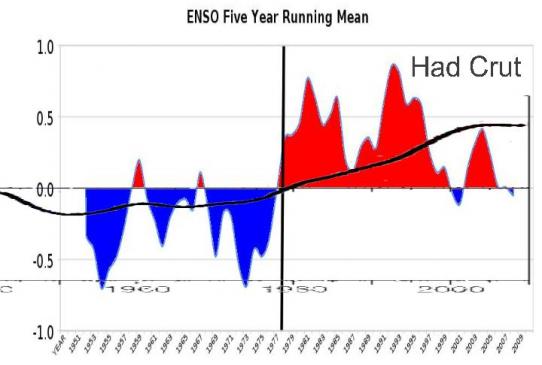Everyone understands this.
El Niño Means Warming – La Niña Means Cooling
El Niño Means Warming – La Niña Means Cooling
El Niño Means Warming – La Niña Means Cooling
It is beyond my comprehension why anyone would seek to force fit an alternative explanation based on CO2 since 1975/particulates from 1940-1970/solar forcing before 1940 etc. – when the ENSO explanation explains the temperature trend extremely well and much more elegantly.



Your graph shows it warming even during La Nina.
This shows the relationship better.
http://data.giss.nasa.gov/gistemp/graphs/Fig.E.lrg.gif
ENSO can’t explain the long term warming.
Yes it can. It is the same data only harder to understand. The warming period is dominated by El Nino. That is why I use a five year running mean.
Steve
“Everyone understands this.
El Niño Means Warming – La Niña Means Cooling”
Unfortunately you seem to have little understanding.
El Nino and La Nina don’t create or destroy heat. They transfer heat from one area to another. They don’t account for long term warming.
Exactly. That is why we should be looking at the 0.7C / century long term trend instead of Hansen’s 2.0C positive PDO trend.
Glad to see you coming around.
“Glad to see you coming around.”
I don’t understand. In your post you asked for an alternative explanation based on CO2. You now mention 0.7C which is about as much as the science suggests we have warmed due to GHG increases.
Brendon:
ENSO and other phenomena are only indicators of long term natural climate variations.
The graph shows there are times / periods that EL NINO is dominate and times / periods that LA NINA is dminate. This tracks fairly well with PDO and SOI phases. However this is only a small part of the natural ebb and flow of nature as it only represents a few years in a period on a few billion years this globe has experienced variable weather / climate.
That GISS temp you referred to, Is that the Brothers Grimm version.
The latest Channel 5 AMSU A temps are now below last years so match surface level being lower finally. It will be interesting to see how low they go.
The 12th month average has not got below zero since before Steve was born !
Andy
Did they have microwave sounders on Sputnik?
ENSO/PDO have a clear impact on global temeratures. No-one could argue with that. The cycle length is around 60 years for PDO.
Biggest influence on climate is the sun. That should come as no suprise. There is the well known 11 year cycle of sunspots, which has a minimal impact on climate. More important are the longer cycles, which are less well understood.
My understanding is that the longer solar cycles impact on climate is due to sun’s varying magnetic field. When the sun is very active (many sunspots) the sun’s magnetic field is strong. This strong magnetic field deflects galactic cosmic rays away from the inner solar system (including the Earth). Galactic cosmic rays act as nuclei for the formation of clouds in the Earth’s atmosphere. Less galactic cosmic rays = less clouds. Less clouds = higher temperatures on Earth.
Obviously when the sun is in active the reverse is true. Worth a look on this is the work of Henrik Svensmark.
http://sc25.com/index.php?id=246
Also worth pointing out the IPCC global climate models are very poor at modelling clouds.
Bottom line is, if the sun stay’s inactive we are in for cold weather for some time.
La Nina means cooling. Wait for the October UAH temps, i think you might have been a bit conserative Steve if im reading the graph right…through the floor its going, as Roy Spencer and Joe Bastardi have been saying as well as yourself.
There was an excellent bit of research by Roy Spencer a few months back on WUWT where he “trained” a relationship between ENSO and global temperatures from the early 20th century, then ran it forward and showed that ENSO predicted temperatures 50 or more years forward.
Of course the cat’s chorus (catastrrophist’s chorus) sang back that causality was the other way round – warming temperatures drive the ENSO cycle. But they didn’t deny the relationship – at least on that post.
ENSO itself probably is not the primary driver of multidecadal temperature change – as Bob Tisdale clearly shows there is ocean heat loss and gain with el Nino and La Nina cycles. The underlying drivers are solar and / or internal oceanic cycling mediated by upwelling. The ocean-climate system could well be a periodically forced nonequilibrium oscillatory system with the forcing coming from the various solar periodicities and planetary barycentric oscillation, illiciting in response emergent oscillations that do not necessarily bear any simple relationship to the forcing frequencies and are not necessarily stationary.